Speech The Australian Economy: Then and Now

Glenn Stevens
[1]
Governor
Address to the Inaugural Faculty of Economics and
Business Alumni Dinner,
The University of Sydney
Sydney –
Chancellor, Vice-Chancellor, Deputy Chancellor, Deputy Vice-Chancellors, Dean of the Faculty of Economics and Business, distinguished guests, ladies and gentlemen.
I think the last time I was in this Hall may have been for my graduation. If not then, it was probably for an examination. Either way, tonight's occasion is far more convivial and I thank the University for the invitation.
One of my classmates of old suggested that a good topic for this conversation might be a comparison of the Australian economy of the late 1970s, when we were students, with that of today. The more I thought about that suggestion, the better it seemed and so that comparison is exactly what I propose to offer. In the moment-by-moment focus on the economic data, and all the wiggles and ticks up and down of this indicator or that, we can often neglect to stand back and look at the big picture. So let us rectify that for the next 25 minutes or so.
The approach is to use graphs and tables to compare two decades – the 1970s and the 2000s, so as to offer some perspectives on how things have changed and, perhaps, on how they are similar.
Economic structure
Table 1 gives a comparison of the structure of the economy by industry then and now. The two most striking changes are the decline in the share of output provided by manufacturing, and the rise in financial and business services. This trend has occurred in all developed countries. Agriculture is smaller than it was then, though 2007 was a drought year, which affects that comparison. Communication services have become more important (the mobile phone was not invented in 1977, of course. What did students do between lectures, I wonder?) Mining is larger today, though not by much.
| 1977 | 2007 | |
|---|---|---|
| Manufacturing | 16.4 | 10.1 |
| Financial, property and business services | 12.4 | 19.5 |
| Wholesale and retail trade | 11.1 | 10.3 |
| Education, health and community services | 9.2 | 10.0 |
| Utilities and transport | 6.6 | 6.8 |
| Construction | 6.3 | 6.8 |
| Mining | 5.9 | 6.8 |
| Government administration and defence | 4.9 | 3.9 |
| Rural | 3.7 | 2.1 |
| Communication services | 0.7 | 2.7 |
| Other | 22.9 | 21.2 |
|
Source: ABS |
||
Beyond these shifts, not all that much has changed at the broad structural level. Australia even 30 years ago had quite a substantial services sector, and still does.
But the opening up of Australia to international trade, as a result of the policies of tariff reform and product market liberalisation since the mid 1980s, has been a significant change (Graph 1). The change in our trade patterns has been substantial (Table 2). In the late 1970s, over 60 per cent of Australia's trade was conducted with the United States, major European countries and Japan. While these countries continue to be important to Australia today, their share of Australia's trade has fallen by a third and is now eclipsed by our trade with China and emerging east Asia. This feature reflects the growing importance of China and emerging east Asia more generally – together, their share of global GDP has trebled to almost 18 per cent since the end of the 1970s.
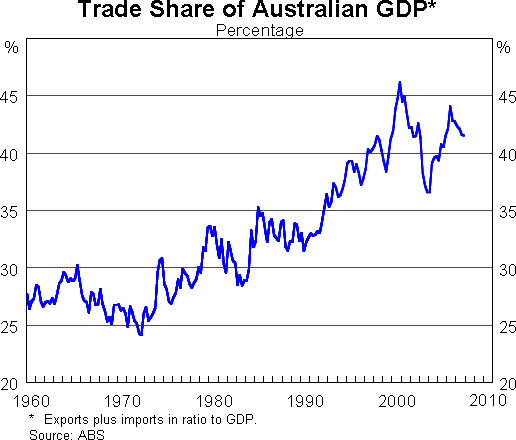
| 1977 | 2007 | |
|---|---|---|
| Japan | 26.9 | 14.3 |
| Major European countries | 20.5 | 16.3 |
| United States | 14.4 | 9.9 |
| Other east Asia | 8.5 | 29.5 |
| China | 1.3 | 14.3 |
|
Notes: Data for financial years. UK included in Major European countries. Source: ABS |
||
External influences on Australia are also reflected in our terms of trade (Graph 2). A key feature of the early 1970s was the spike in our terms of trade as supply disturbances pushed up world commodity prices. Today, rising commodity prices are again a feature of the global economy. However, this time around, much of the rise in our terms of trade appears likely to be more sustained, resting as it does on the demand arising from the long-term emergence of large economies like China and India.
The more open economy today also means we are more exposed to these forces. In addition, the opening of the capital account in the early 1980s has led to a degree of integration of the Australian financial system with the world in a way which offers a much larger choice set to savers and investors.
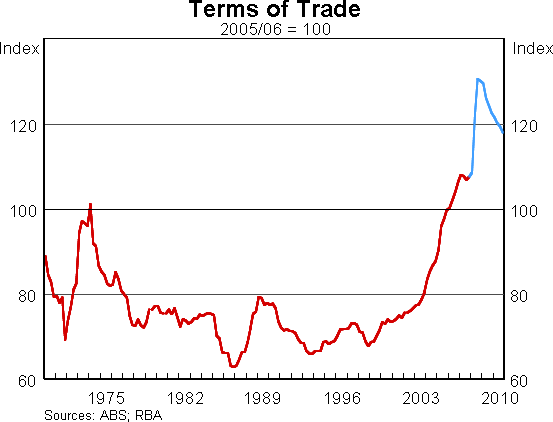
Macroeconomic trends
My next set of comparisons is of major macroeconomic aggregates. The first is growth in real non-farm GDP. I use non-farm GDP simply because farm GDP can be highly volatile due to droughts and floods. That, as rural producers know only too well, has been a constant feature of the Australian experience.
On average, growth in the economy in the two periods under review was very similar, at about 3.4 per cent (Graph 3). But there was a marked change in the middle of the 1970s. After a number of years of very rapid growth, the economy encountered much more adverse circumstances from 1974 onwards. That was true for most countries, though Australia's relative performance on some metrics deteriorated. From 1975 to 1979, the average growth rate was a full percentage point lower than in the period from 1971 to 1974. The period was also noteworthy for the close proximity of two episodes of cyclical weakness, in 1974–1975 and 1977. There was also a recession in the early 1980s.
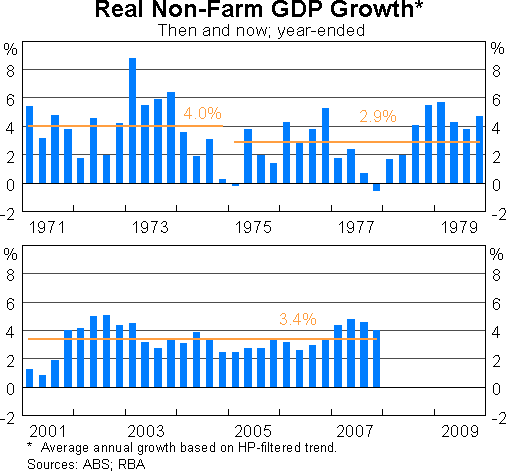
The current decade so far has seen average growth of 3.4 per cent, though the next couple of years will probably see growth noticeably lower than that. What is quite noticeable from the graph is the relative stability of growth in recent years, something that was a feature of the second half of the 1990s as well. This pattern was observed in many economies over the same period. Of course, the 1970s makes for a flattering benchmark in that it was the most unstable period in macroeconomic terms in the entire post-War period, so even average performance will look better than that. But, in fact, the period since the mid 1990s has been very stable by any standard. Those who have looked into this in detail have posited several possible contributing factors, including better macroeconomic policy frameworks, a wide range of microeconomic reforms in labour and product markets, and luck.
The weak growth of the latter 1970s was associated with an upward trend in unemployment (Graph 4). From a low of 2 per cent in the early 1970s, it rose to about 5 per cent in the mid-1970s recession, and then drifted higher over the remaining part of the decade. Similar trends were observed abroad. The big rise in real wages in the mid 1970s, part of which was exogenously imposed as a result of government policy at the time, also had a fair bit to do with higher unemployment.
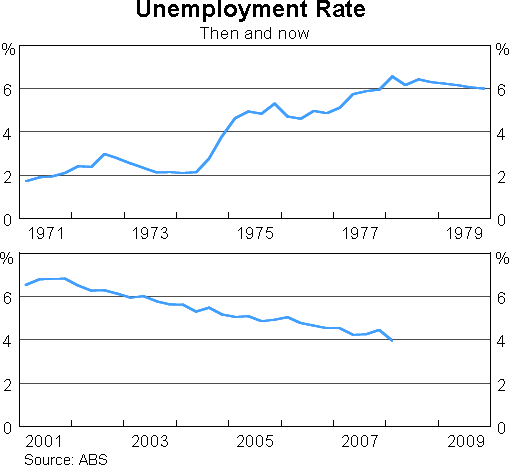
The trend in unemployment in the most recent decade has generally been downward. Following a rise of a percentage point in the economic slowdown in 2001, it has fallen to the lowest levels since the mid 1970s. The long expansion, with occasional temporary pauses, has done a lot to foster lower unemployment. But the changes in labour market arrangements over the past 20 years or so have also been very important. Indeed, I would argue that they are a key contributor, not least because they have facilitated the longer length of economic expansions.
The difference in inflation rates between the two decades is particularly striking (Graph 5). Being a central banker I suppose I would say that, but I think it is too easy to forget the corrosive effect that high inflation had on the economy in those days. Until the mid 1960s, Australia had been a low-inflation country. The seeds of the 1970s inflation were sown in the latter part of the 1960s, they took root in the early 1970s and then the events of the early and mid 1970s pushed inflation up steeply. From the end of 1970 to the end of 1979, the average rise in the CPI was 10.7 per cent a year, which meant that the value of money fell by 60 per cent over that period. The peak inflation rate in any one year was 17.6 per cent, and the lowest achieved was just under 5 per cent.
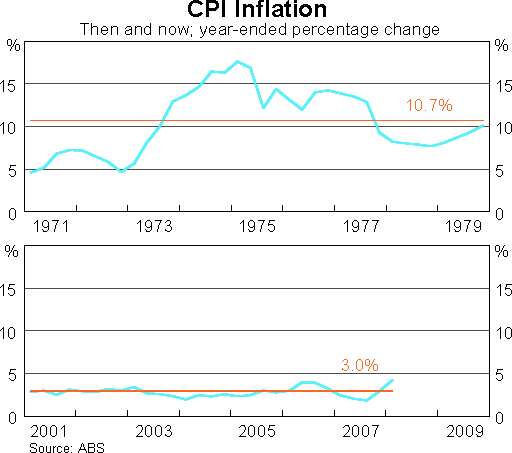
In contrast, the current decade shows a pretty flat line for inflation when put on the same scale as the 1970s. We still have our cyclical ups and downs, but the average rate has been 3.0 per cent since the beginning of 2001. Even with the recent surge in consumer prices taking the inflation rate to a bit over 4 per cent, things are not like they were in the 1970s. That's just as well, of course, because with entrenched high inflation would come lots of distortions and wasted resources as people in the economy adjusted their behaviour to live with high inflation. One of the adjustments would be that savers would demand higher nominal interest rates, higher than the ones we currently see, to part with their money.
So the period between about 1973 and 1983, when the economists of my generation were studying and then getting their first jobs as economists, was a pretty poor one for macroeconomic performance. The past decade, in contrast, has been much better. Once again, a more favourable international environment has been a factor there, but so have better economic policies. Let me turn, then, to economic policies.
Macroeconomic policies
When we were students, we were taught about the four arms of economic policy, which were fiscal, monetary, exchange rate and wages policies. We still have fiscal and monetary policy, about which I will say something in a moment. But by the early 1980s, enough people had accepted that you could not really choose the exchange rate and monetary policy settings independently. You either allowed financial conditions to adjust to whatever was dictated by a given exchange rate, or you set domestic financial conditions according to the needs of the economy and let the exchange rate adjust to that. The decision to float the exchange rate, made in 1983, was a decision to do the latter. Of course, there have been subsequent occasions when, via intervention, we have sought to influence the exchange rate, but they have been confined to fairly brief periods and have become less frequent as time has passed.
Wages policy was important for the wrong reasons in the 1970s, in that government pushed up minimum wages too quickly for a while. In the 1980s, wages policies negotiated in the form of the Prices and Incomes Accord between the Hawke/Keating Governments and the ACTU were effective in containing wages growth and allowing some restoration of the share of national income accruing to profits. This did a lot to generate employment and growth. It seems unlikely that such a degree of influence over wages as an instrument of macroeconomic policy will return. These days, policies over industrial matters are more structural in nature, aimed at making arrangements in the labour market reasonably flexible, balancing economic efficiency and fairness, and providing a safety net for the lowest paid.
So that leaves monetary and fiscal policy. When I was a student, furious debates had long been boiling away in the halls of academia over questions like: does money matter? Was monetary or fiscal policy more effective as a stabilisation tool? Was the apparent trade-off between inflation and unemployment, which appeared so tantalisingly in the data, something that could be exploited systematically, or would it prove ephemeral? Was discretion best in the conduct of monetary policy, or should some sort of rule be employed?
The 1970s and early 1980s provided important real data and experience in the resolution of these questions. Friedman and Phelps had already long argued that there was no long-run trade-off and that attempts to reduce unemployment below some structural level by accepting higher inflation would simply result in accelerating inflation and no lasting gain on unemployment. The 1970s seemed to demonstrate that this was right. More strident derivatives of the Chicago tradition, however, which insisted that there was not even any short-term trade-off, were found to be wide of the mark.
Money did seem to matter, since the big rise in inflation in the 1970s had been preceded by a large increase in money growth. A lot of people not only accepted that monetary quantities were the key thing to look at, but concluded that central banks had failed to control them, so that some sort of step away from unconstrained discretion towards monetary rules was advisable. As a result, targets for those quantities were adopted, including in Australia. That was the language of discussion when I was a student and when I first started work at the Reserve Bank in 1980.[2]
These days, we have inflation targeting, an arrangement that provides a measure of constrained discretion to the central bank within a medium-term framework. It emphasises the control of inflation over time, but does not seek to fine-tune inflation over short periods. That allows a reasonable accommodation for trends in economic activity and employment over periods of a year or two, about which the Reserve Bank is required to have concern by its Charter as well as by common sense, but preserves the value of the currency over the long run. In the language of trade-offs, this system accepts there is a short-term growth/inflation trade-off, but also accepts there is no long-term one. Inflation targeting does not ignore financial quantities, but does not elevate them to the status of an intermediate target and does not see them as an instrument. Inflation targeting is not perfect and, on occasion, still leaves policy-makers with some quite difficult decisions to make. It is, however, the best system that has been devised as yet.
The fiscal debate of the 1970s was dominated by the budget deficits of the period, and the need to reduce them. On contemporary figuring, the Commonwealth's budget deficit reached about 4–5 per cent of GDP in the middle years of the decade. Using figures comparable to those in use today, which measure the underlying cash balance of the Commonwealth general government sector, the deficits of the mid 1970s amounted to only about 2 per cent of GDP (Graph 6). But until 1974, the Australian general government sector had recorded more or less continual significant surpluses, so the turn to deficit in 1975/76, for the first time since the early 1950s, was substantial and, at the time, quite controversial. Reducing the deficit in the sluggish economy of the late 1970s was hard. Deficits grew much larger in the recessions of the early 1980s and early 1990s.
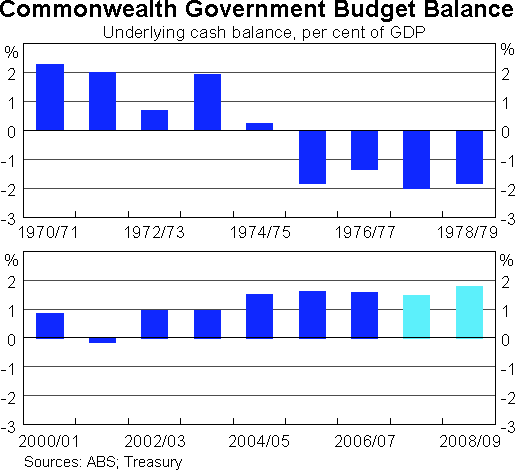
Since 1997/98, in contrast, the federal budget has been in surplus continually, apart from a very small deficit in one year. The government's net debt has been retired. Gross debt on issue is maintained at a small size in order to facilitate a functioning bond market so as to allow efficient risk pricing more generally. As with monetary policy, there is a medium-term framework for fiscal policy emphasising balance over the business cycle. There is much less inclination today than there once was to use fiscal policy as a counter-cyclical stabilisation tool.
Significant fiscal challenges in the long-term include health spending and responding to population ageing, as the very important work by officers of the Australian Treasury has made clear. But there would be very few countries, if any, which would not envy Australia's fiscal position. The capacity to respond, if need be, to developments in the future is virtually without peer. This seems light years from the situation in the late 1970s.
I have said little here about the changes to microeconomic policies, which do so much to determine the economy's supply-side responsiveness. That is because my field of interest and expertise is in the macro sphere. But these microeconomic changes were equally as important as the macro ones, maybe even more important. I mentioned the change in labour market policy, but this was accompanied by a host of other changes to factor markets (like financial liberalisation) and product markets (tariff reform, competition policies and so on). It is actually these policies that have done most to improve the living standards of Australians. The contrast between the Australian economy of 1977 – heavily regulated, suffering poor productivity growth, sheltering behind high barriers to foreign competition – and the much more open and productive one of today is striking.
The teaching of economics
The final comparison I offer is in the teaching of economics. Of course I do not sit in lectures or tutorials, so I am unable to judge whether or not the face-to-face teaching has changed since the late 1970s. But one interesting exercise is to compare the text books used today with those in the past.[3] I understand that at the University of Sydney a popular text is the Australian edition of Ben Bernanke's Principles of Macroeconomics (co-authored with Robert Frank, with the Australian edition adapted by Nilss Olekans). When I studied macroeconomics in 1977, the text in use was Fred R Glahe's Macroeconomics, published in 1973.
One interesting difference that is obvious immediately is the less formal layout. I think it is fair to describe Glahe's text as rather formidable and austere, and perhaps not a particularly inviting read. In contrast, the book by Bernanke et al is much more welcoming, challenging students with thought-provoking questions and illustrations on how economic theory relates to tangible real world events.[4] Perhaps the less formal presentation style says something about how society has changed over the past three decades, but I think it also reflects an economic force at work, and that is competition. There is a proliferation of new macroeconomic textbooks, many by highly regarded economists. This competition seems to have spurred authors to try to produce the most appealing text for students and lecturers in order to capture market share. To the extent that these texts may help to cultivate an interest in economics, this has been a positive development.
On content, both include discussion of the ‘money multiplier’, as an introduction to the theory of fractional reserve banking. I suppose students have to learn that, and it is easy to teach, but most practitioners find it to be a pretty unsatisfactory description of how the monetary and credit system actually works. In large part, this is because it ignores the role of financial prices in the process.[5] Bernanke et al do, however, discuss some aspects of financial markets, and I note that in the most recent US edition of the text this has expanded to cover asset prices, the diversification of risk and the role financial markets play in ensuring savings are allocated to their most productive uses. In the shadow of the current dislocation in global financial markets, this is obviously a pretty valuable addition to the curriculum. Ben Bernanke has also, of course, made major contributions to academic literature in these areas over the years.
The 1970s book was full of discussion about monetarists versus Keynesians, and of short-run and long-run Phillips curves. The later book confines them to a section called Lessons from the Past.[6] Whereas Glahe's 1970s text makes extensive use of the IS-LM framework from Sir John Hicks' exposition of ‘Mr Keynes and the Classics’ in the 1930s, IS-LM per se does not rate a mention in the modern undergraduate text book.
But perhaps the biggest difference is in the treatment of the open economy, exchange rates and so on. In Glahe's 1973 book, the analysis is conducted entirely in a closed economy setting. The term ‘exchange rate’ is not one that appears in the index. Today, even the United States sees itself as an open economy, and the Bernanke et al book treats the issue carefully and even contains some international comparisons of data.
What do we take from all that? At the risk of offering a set of sweeping generalisations, I would observe, first, that some of the things which so preoccupied us in the 1970s about the role of monetary policy, the nature of trade-offs, both short and long term, between inflation and growth or unemployment have been regarded by the mainstream of the profession as pretty much settled. At least, they have been as settled as things ever get. It is to be hoped, of course, that we do not have to re-learn those lessons, which is why I have been making the case to resist inflation even though that is not comfortable or convenient in the short run.
Second, the theory and practice of mainstream macroeconomics has become more international in focus. This trend will surely continue, in response to the course of events. Not only have the effects of bad loans to American home buyers had reverberations much further afield, but the rapidly growing size of the emerging world is affecting economic activity and prices far beyond their own borders. I would hazard a guess that the textbooks of 30 years from now (if we are still using books) will devote large slabs of material to that emergence, and to how well the ‘old industrial countries’ adjusted to it. They will also, no doubt, cover the economics of climate change and its abatement at some length.
Conclusion
That is my thumb-nail sketch of the Australian economy, and economics generally, then and now. Of course, this is not a very rigorous treatment and many things have been omitted. But this is supposed to be a relaxed occasion.
Re-reading some of the material, and looking at the data, takes one back. I should not mention many particular names, but Professor Warren Hogan, still active in developing policy thinking, was one figure of importance. Peter Groenewegen's courses in the History of Economic Thought were memorable, as was the course in Economic Classics that he taught with Colin Simkin. Those courses introduced me and others to Smith, Ricardo and Wicksell, as well as to the then-standard fare of Keynesians and monetarists. And who among the honours classes of the late 1970s will forget the aroma of coffee brewing in the corner of Prof Simkin's study, his desk clouded in cigarette smoke, the students sitting, terrified, waiting for the interrogation ahead about the use of Kakutani's fixed point theorem to prove the existence of general equilibrium? Some things are harder than monetary policy!
It was an enormous privilege to attend the University of Sydney, to have made some very good friends (whom I have still), and to have encountered some remarkable teachers who introduced us to the study of economics. It was marvellous to have been a part, however small and fleeting, of the life of this place three decades ago, and a great honour to have resumed that association in this way tonight.
Endnotes
I thank Clare Noone for assistance. [1]
Australia's success in using monetary targeting was mixed, as it was in most countries. The tools to exert control over those measures of money were not really available. The liberalisation of the 1980s solved these problems but also shifted the relationships between the monetary aggregates and the economy, which meant there was no confidence that hitting a monetary target would produce the outcomes we really wanted on inflation. In this environment, policy struggled for many years to unwind the rise in inflation of the 1970s. It was not decisively brought down until 1992, which was long after monetary targeting had been discontinued. [2]
I am indebted to Clare Noone for the suggestion of conducting this comparison. [3]
Missing from the Australian edition is the set of pithy cartoons illustrating simple economic truths, which is a shame. [4]
For what it is worth, I think that the Wicksellian notion of the natural rate of return on capital, the market interest rate and the dynamics set in train by the differences between those two rates is one of the more useful analytical devices for understanding the modern economy with a private credit system. Wicksell wrote about it more than a century ago. (Knut Wicksell, Geldzins und Güterpreise: Eine Studie über die den Tauschwert des Geldes bestimmenden Ursachen, 1898, published in English as Interest and Prices: A Study of the Causes Regulating the Value of Money, 1936.) Neither of these books covers that idea, though to be fair I learnt about that in my honours year, rather than in intermediate undergraduate macro courses. (I trust students today are still taught this at some point.) [5]
In fact, the most recent US edition of the text makes no explicit mention of these debates at all. [6]
References
Bernanke BS, N Olelkalns and RH Frank (2005), Principles of Macroeconomics, McGraw-Hill Australia, North Ryde.
Frank RH, BS Bernanke and RT Kaufman (2007), Principles of Macroeconomics, 3rd edn, McGraw-Hill/Irwin, Boston.
Glahe FR (1973), Macroeconomics: Theory and Policy, Harcourt Brace Jovanovich, New York.
Wicksell K (1898), Geldzins und Güterpreise: Eine Studie über die den Tauschwert des Geldes bestimmenden Ursachen, Gustav Fischer, Jena, trans RF Kahn, Interest and Prices: A Study of the Causes Regulating the Value of Money, 1936, Macmillan and Co., Limited, London.